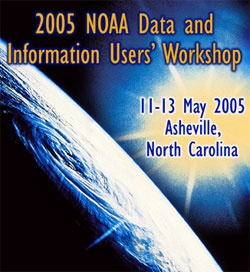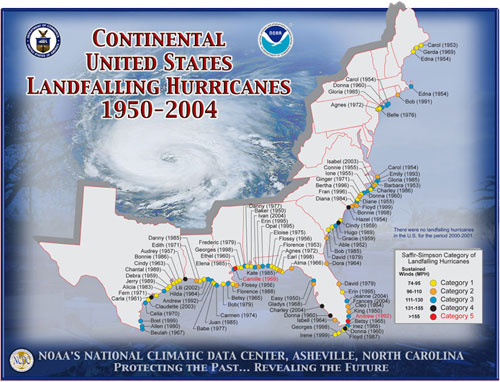
1) Utility of NOAA data supplied
to users A total of 204 participants
were in attendance including
users from academia, the research
community, the private sector,
and other government agencies.
The workshop consisted of presentations
on the status of NOAA data distributors,
panel sessions, customer breakout
sessions, and a tour of the National
Climatic Data Center (NCDC).
Welcoming remarks were given
by Dr. Thomas R. Karl, director
of NOAA’s National
Climatic Data Center in Asheville.
Understanding, assessing, predicting, mitigating and adapting to climate variability and change
GEOSS involves integration of both observation systems and data management systems. Through both vertical and horizontal integration, GEOSS will address the needs of users in a wide range of areas, including human health and well-being, natural and human induced disasters, weather information, energy resources, water resources, climate variability and change, sustainable agriculture, biodiversity, and terrestrial, coastal, and marine ecosystems. On May 12 th a panel discussion took place which provided an opportunity for data users to provide feedback to NOAA. The Moderator for the discussion was Dr. Leonard Pietrafesa, chair of the NOAA Science Advisory Board. Four panelists were selected for the discussion and were given one area of focus: Climate and Weather, Oceans, Coastal, or Geophysical. Each panelist was asked the following questions:
Each panelist thoroughly answered the questions provided. To improve feedback and communications Dr. Branscome suggested providing direct contact to NOAA personnel familiar with technical details of data, to announce and preview upcoming changes, and improve mechanisms for receiving and responding to suggestions for major/minor changes in data products, tools, formats and access. Dr. Matthew Howard, Research Scientist at Texas A & M, suggested NOAA’s impact to society could be measured by measuring the number of bytes that are transferred, counting literature citations involving NOAA data, and through user surveys initiated through newsletters. On May13th the workshop concluded with an optional tour of NCDC. The NCDC is the world’s largest active archive of weather data. It produces numerous climate publications and responds to data request from all over the world. The workshop was very well organized and provided useful information on NOAA products and services. It also provided an opportunity to express questions and concerns regarding NOAA products. Report from Mrs.
Keisha Wilkins |
 The NOAA
Data Users Conference was held
May 11 th – 13 th, 2005
in Asheville, North Carolina.
The purpose of the workshop was
to describe NOAA’s plans
for new information, products
and services and to establish
a closer working relationship
with users of NOAA’s data
and products. Several of NOAA’s
scientist, researchers, and technicians
provided information on existing
and upcoming products. In addition
NOAA desired feedback from data
users regarding four areas:
The NOAA
Data Users Conference was held
May 11 th – 13 th, 2005
in Asheville, North Carolina.
The purpose of the workshop was
to describe NOAA’s plans
for new information, products
and services and to establish
a closer working relationship
with users of NOAA’s data
and products. Several of NOAA’s
scientist, researchers, and technicians
provided information on existing
and upcoming products. In addition
NOAA desired feedback from data
users regarding four areas: 
 On May 12th and 13th breakout
sessions took place. These sessions
were divided into four categories:
Climate, Weather, Geophysics,
and Oceanography. Participants
were asked to choose a session
and were given a list of questions
to discuss. At the end of the
breakout session on May 13 th
feedback was provided from all
of the groups. Mr. Brian Hughes
was in charge of the Weather
breakout session. Several recommendations
were provided by the group. Some
of these include that standards
be made more universal and that
data be more consistent. For
example, the location, time reporting,
and station measurement time
should remain consistent. It
was also suggested that better
backup power and communications
and increased resolution of numerical
models are types of technologies
that will be valuable in the
future.
On May 12th and 13th breakout
sessions took place. These sessions
were divided into four categories:
Climate, Weather, Geophysics,
and Oceanography. Participants
were asked to choose a session
and were given a list of questions
to discuss. At the end of the
breakout session on May 13 th
feedback was provided from all
of the groups. Mr. Brian Hughes
was in charge of the Weather
breakout session. Several recommendations
were provided by the group. Some
of these include that standards
be made more universal and that
data be more consistent. For
example, the location, time reporting,
and station measurement time
should remain consistent. It
was also suggested that better
backup power and communications
and increased resolution of numerical
models are types of technologies
that will be valuable in the
future.